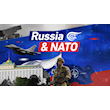Russian weapons factories outputting multifold increases in production
The head of Rostec has put out a detailed report of increases in the production of systems and munitions amid the ongoing conflict in Ukraine.
-

Russian Defense Minister Sergei Shoigu, second right, visits a factory workshop as he checks the implementation of the state defense order at an enterprise of the military-industrial complex in the Omsk region of Russia, which produces tanks and TOS heavy flamethrower systems, on Friday, April 19, 2024. (Russian Defense Ministry Press Service)
Russian industrial complexes have increased weapons and systems production by multi-folds amid the ongoing Special Military Operation in Ukraine, the head of the defense conglomerate Rostec, Sergey Chemezov, told Russian Prime Minister Mikhail Mishustin during a meeting on Friday.
Around 80% of military equipment used by the Russian Armed Forces is currently being supplied by Rostec, according to Chemezov. He revealed that the production and refurbishment of Russian tanks has increased by 3.5 times since 2022, while the same processes have seen a three-fold rise for lightly armored vehicles.
As for the manufacturing of self-propelled artillery pieces, Rostec is producing 10 times what it used to. The production of towed guns has witnessed a 14-fold rise since 2022. Artillery pieces are in high demand due to the nature of the conflict between Russia and Ukraine, which has heavily depended on unprecedented amounts of shelling and indirect methods of attack to secure areas of control and to set up offensive maneuvers.
A highly valuable asset of the Russian army has been multiple rocket launch systems (MLRSs), which provide a wide array of coverage, in the form of instantaneous salvos of rocket artillery weapons. Chemezov said that the production of these systems has doubled since the outbreak of the armed conflict.
Read more: Ukraine withdraws Abrams tanks due to 'inflated expectations': Report
Russian factories meet war-time demand for shells and munitions
As for the production of rounds for these systems, Russia has recorded a substantial increase to meet war-time demands, a feat that Ukraine and its Western backers have struggled to achieve.
In detail, Rostec has increased its output of ammunition rounds for tanks and infantry fighting vehicles by 900%, artillery shells by 600%, and munitions for MLRSs by 800%.
Round for the TOS-1 system, which is armed with multiple thermobaric unguided rocket artillery, has been increased by three times alone. Chemezov also revealed that Rostec introduced an improved version of the system, the TOS-2 heavy flamethrower system.
Moreover, the Russian military-industrial complex is working on meeting the ever-changing demands of the conflict by producing new systems such as the Zemledliye remote mine-laying system, the Krasnopol guided shells, and the Kub short-range loitering munitions.
Russia has also heavily invested in transforming large-caliber "dumb bombs" into air-launched precision-guided munitions. By equipping these bombs with guidance kits, the Russian Air Force is now able to precisely target enemy locations from long-range distances.
The war in Ukraine has taken a heavy toll on both sides. However, the persistence of Western aid to Kiev has turned this into a long war of attrition, in which both willpower and the ability to produce the necessary equipment and munitions to sustain the fight have become crucial. Experts believe that the side capable of delivering larger quantities of munitions, especially artillery shells, to the battlefield will emerge victorious. This underscores the critical need to expand military production in terms of both quantity and quality, which is currently giving Russia the upper hand in the conflict.
Read more: Russian MFA: US giving Ukraine weapons to fight 'till last Ukrainian'

 3 Min Read
3 Min Read









